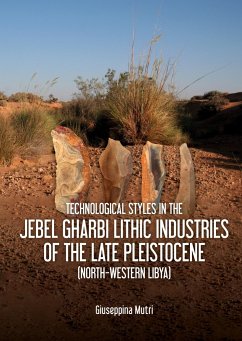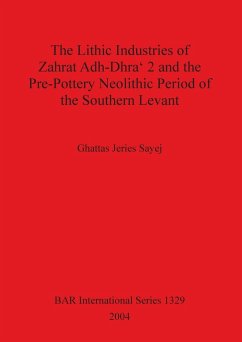
Technological Styles in the Jebel Gharbi Lithic Industries of the Late Pleistocene (North-Western Libya)

PAYBACK Punkte
13 °P sammeln!
The study of the human societies of the Final Pleistocene of North Africa requires an in-depth analysis of the techno-typological characteristics of the microlithic industries that were widespread in the whole Mediterranean area during the period between 24000 and 10000 years ago.Most of the research projects in Maghreb and Libya were carried out decades ago. At the time sediments were rarely sieved and the small lithic tools, so characteristic of this period, were often lost. Also, little attention was paid to the raw material sourcing, which is an exceptional tool for understanding technolog...
The study of the human societies of the Final Pleistocene of North Africa requires an in-depth analysis of the techno-typological characteristics of the microlithic industries that were widespread in the whole Mediterranean area during the period between 24000 and 10000 years ago.Most of the research projects in Maghreb and Libya were carried out decades ago. At the time sediments were rarely sieved and the small lithic tools, so characteristic of this period, were often lost. Also, little attention was paid to the raw material sourcing, which is an exceptional tool for understanding technology, human behavior and land management. It is thus of great importance to focus on new research, that has the potential to delineate a more detailed picture of the North-African Later Stone Age.Based on more recent research in the Jebel Gharbi (Libya), this book offers a high-resolution description and documentation of the LSA lithic complexes of North-Western Libya, applying an approach thatintegrates up-to-date techno-typological studies with geochemistry and functional analysis. This research aims to define the characteristics of the human occupation of the Jebel Gharbi during the Late Pleistocene, with specific reference to the period from the Last Glacial Maximum to the Holocene transition, delineating a picture of the human occupation of the area through about ten millennia. This volume represents an exhaustive overview on the Prehistory of Northern Libya in areas that aren't, nowadays, accessible to researchers.ContentsIntroductionChapter 1: Hunter-Gatherer societies in the north african context: History of studies, definitions, chronology.Chapter 2 : Jebel Gharbi, environment and culturesChapter 3: From the artifact to society: lithic industries, study methods used. Archaeometry, techno-typological analysis, functional analysis and experimentationChapter 4: Raw material: distribution, analysis and characteristics of flint outcrops in Jebel Gharbi.Chapter 5: The study sample in the Shakshuk and Wadi Ghan areas.Chapter 6. From the industry to the site. Techno-functional experimental study of lithic artefacts.Conclusion: The Jebel Gharbi sequence in the framework of hunter-gatherer societies in North Western Africa.Final Remarks












